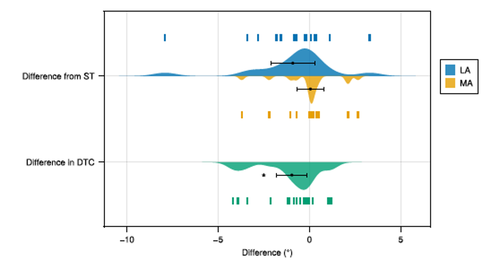Recommendation: 1

Interlimb coordination in Parkinson’s Disease is minimally affected by a visuospatial dual task
A recommendation of ‘Interlimb coordination in Parkinson’s Disease is minimally affected by a visuospatial dual task’
Recommended by Deepak Ravi based on reviews by Nicholas D'Cruz and 1 anonymous reviewerEffective gait fundamentally requires spatial and temporal coordination of upper and lower limbs. Individuals with Parkinson’s disease (PD) often exhibit impaired coordination, leading to adverse events such as freezing of gait and falls (Plotnik et al. 2008). Despite their significance, the current literature lacks depth in our understanding of this characteristic, especially their adaptation to changing task demands and symptom laterality. Exploring these relationships may provide new insights into PD gait and facilitate the evaluation of potential treatments. With these objectives in mind, the present study conducted by Hill & Nantel (2024) includes 17 participants with mild to moderate PD and focuses on coordination within and between the more and less affected sides during both single and dual gait tasks. In the study, spatial coordination, assessed by range of motion, range of motion variability, and peak flexion for the shoulder and hip joints, was examined alongside temporal coordination, which was evaluated using the phase coordination index and variability of continuous relative phase.
Their analysis reveals that, due to dual tasking, only the shoulder range of motion and peak flexion decreased within the least affected side, adding to the existing knowledge on arm swing impairments in early-stage PD (Navarro-López et al. 2022). However, no significant difference was observed between the more and less affected sides. Hip range of motion showed dual task-related differences between sides, while lower intralimb phase variability did not. The primary strength of the article lies in its attempt to systematically explore these differences in PD. As the authors pointed out, to interpret the clinical significance of these differences as well as the null findings on temporal coordination, it may be necessary to include a healthy control group or other comparison groups, such as individuals with severe PD. When interpreting these results, readers may also pay attention to the methodological choices, such as the patient-reported most affected side and the choice of dual task. Overall, the study will be of interest to researchers studying intra- and inter-limb coordination during gait in PD.
References
Plotnik, M., & Hausdorff, J. M. (2008). The role of gait rhythmicity and bilateral coordination of stepping in the pathophysiology of freezing of gait in Parkinson's disease. Movement disorders: official journal of the Movement Disorder Society, 23(S2), S444-S450. https://doi.org/10.1002/mds.21984
Hill, A., & Nantel, J. (2024). Interlimb coordination in Parkinson’s Disease is minimally affected by a visuospatial dual task. bioRxiv, ver. 3 peer-reviewed and recommended by Peer Community in Health and Movement Science. https://doi.org/10.1101/2022.07.15.500215
Navarro-Lopez, V., Fernandez-Vazquez, D., Molina-Rueda, F., Cuesta-Gomez, A., Garcia-Prados, P., del-Valle-Gratacos, M., & Carratala-Tejada, M. (2022). Arm-swing kinematics in Parkinson's disease: a systematic review and meta-analysis. Gait & Posture, 98, 85-95. https://doi.org/10.1016/j.gaitpost.2022.08.017
